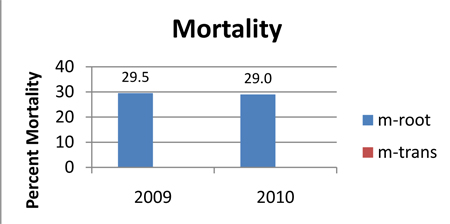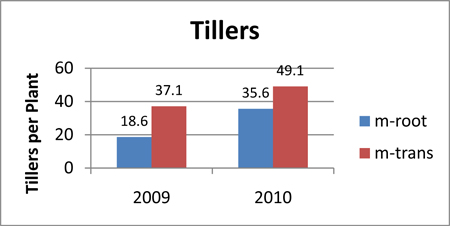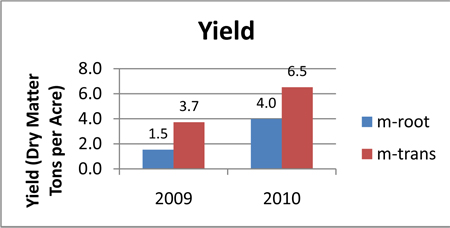Establishing Miscanthus as a bioenergy crop can be challenging
Live plants grown in the greenhouse could help address mortality problems when establishing miscanthus giganteus
Miscanthus giganteus is a warm season perennial grass that is a contender as a cellulosic ethanol crop due to its high yield potential. The giganteus specie is a triploid and does not reproduce through seed. The crop is propagated by dividing rhizomes and replanting the bare roots. Mortality has been a problem in establishing the crop. The research reported here is evaluating if starting rhizomes in a greenhouse and transplanting live plants is a viable way to establish the crop. Economics of establishment will be considered once mature stands are developed. This generally takes about three years.
Purpose: To evaluate current propagation practice to transplanting plugs started in greenhouse
Two treatments:
(1) m-root=bare roots planted directly into field
(2) m-trans=plugs (4” square) transplanted into field
Hypothesis: Planting plugs will produce higher yields and reduce the time to mature yields.
Results
Miscanthus bare roots planted directly into the field had 29.5% mortality in the year planted. Mortality in the second year was similar. This is a real problem that will need to be addressed if large scale planting of miscanthus is to be done. The time it will take a stand to fill in and reach mature yields will be increased significantly.

Transplanted miscanthus plant had a higher number of tillers per plant in year 1 and year 2. The plants generally showed higher plant vigor. The time to reach a full mature stand will be shortened when transplants are used.

In 2010, transplants yielded 6.52 tons of dry matter per acre compared with 3.98. Transplants yielded higher in both years.

Discussion
Use caution when drawing conclusions from this project. While it appears that transplants are superior to bare roots for establishing miscanthus, we need to weigh in the costs of starting the plants in the greenhouse. We need to look at three to four years of data and include economics before we draw a final conclusion.
Funding for this project was provided by Project GREEEN, West Michigan Greenhouse Association, Great Lakes Bioenergy Research Center and Energy Biosciences Institute.
For more information:
Contact Dennis Pennington (pennin34@msu.edu) at 269-838-8265 or on the web at http://bioenergy.msu.edu.



 Print
Print Email
Email




